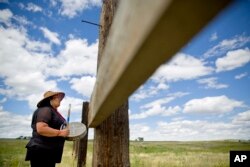Ashley Loring Heavyrunner disappeared from the Blackfeet Reservation in Montana in June 2017, one of thousands of indigenous women recorded missing in the United States and Canada in recent decades.
For professional cartographer Annita Lucchesi, a descendant of the Cheyenne Tribe, the loss was personal: Heavyrunner was her student at the Blackfeet Community College.
Now Lucchesi is putting together an atlas of missing and murdered indigenous women and girls, seeking to map the geographic distribution of such cases.
“Mapping is an indigenous way of knowing,” Lucchesi told the Thomson Reuters Foundation by telephone from California. “It can yield really powerful results, especially for social issues that are hard to discuss, like missing and murdered indigenous women.”
National estimates
A 2014 national report by the Royal Canadian Mounted Police estimated 1,181 indigenous women disappeared or were murdered since 1980. In 2016, the U.S. National Crime Information Center reported 5,712 cases of missing native women.
Lucchesi is not satisfied with those official figures.
Authorities, she said, do not make public their standards for inclusion and might repeat cases when one person runs away from home multiple times.
Database, maps
She has already prepared a comprehensive database of missing or murdered indigenous women and sees the maps, which are part of her doctoral thesis, as a way for indigenous women to share their stories on their own terms.
“We need a good working number of cases of missing and murdered indigenous women and girls in the U.S. and Canada,” she said.
As a U.S. citizen studying at the University of Lethbridge in Canada, Lucchesi understands the justice system on both sides of the border.
Personal experience
She has also experienced domestic violence personally, an ordeal she said spurred her to action.
“If I had been killed I would have wanted a movement to make sure this doesn’t happen to other women and girls,” she said.
More than 4 in 5 Native American women have experienced violence in their lifetime, according to the National Institute of Justice.
While the full atlas is a work in progress Lucchesi has mapped the 119 women whose names, drawn from her database, were carried by protesters during the 2018 Women’s Marches.
“Our stories are inherently tied to the land, so mapping our stories is not quite as big of a jump as people imagine it to be,” she said.

